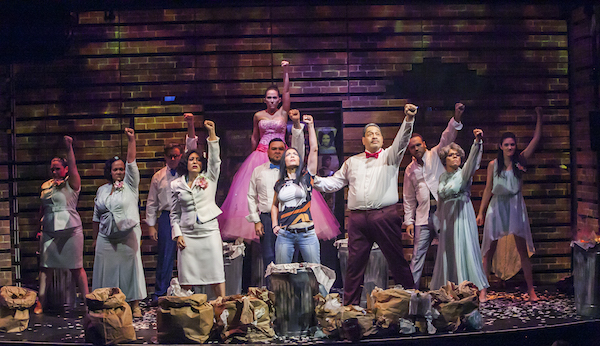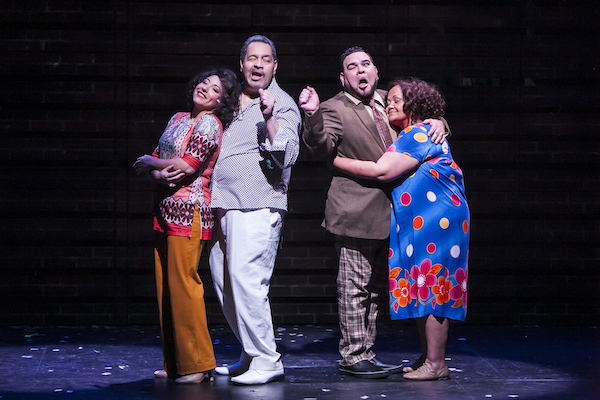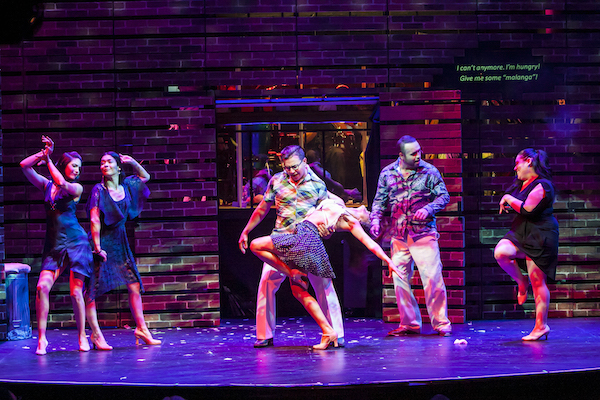
BY MICHELE CARLO | On a metal-gated, garbage can-lined street of tenements and storefronts, the eloquent, energizing rhythm of Salsa music whirls through a doorway. In this record store and upstairs live a family unified in love; soon to be divided by life. Is there a riot or a celebration going on…or is it both? Are we to witness a story of hope and achievement, or loss and betrayal — or will it be both? And then there’s the music again; the unmistakable, transporting Latin music.
Welcome to “I Like It Like That,” a musical set in El Barrio, aka Spanish Harlem, during the 1970s. The decade NYC nearly went bankrupt and blacked out; where crime, drugs and graffiti ruled the streets; and where a group of woke individuals turned protest into a force for social justice and change whose reach still exists today. A neighborhood whose music came to represent its people and culture during a time when all seemed poised on the wrong side of a sword. And through it all, a father struggles to keep his family hale and whole.
It’s a celebration of old-school Puerto Rican culture: street parties and Valencia cake, culture clashes between generations amid poverty and neglect, the battle between the lure of the street and the desire to become something more than the powers that be want you to believe you can be (along with the backlash that you’re not “keeping it real” if you do choose to leave). I know this NYC; I grew up in it as well, albeit in a different neighborhood.
Yes, the dialogue was sometimes an excuse to get to the next song — but what songs! The numbers include works by seminal musicians Eddie Palmieri, Hector Lavoe, Tito Puente, La Lupe, Johnny Pacheco, Willie Colon, Fania All-Stars, and more — plus Manny Rodriguez and Tony Pabon, who wrote the title song. And, since this is a musical, we forgive any momentary timeline confusion or clunkiness of phrase while transfixed by the joyous explosion of hips, hair, and feet. Just ask the friend I brought that evening, a full-blooded Caucasian WASP who I thought might leap from her seat in delight at any given time.

Unfortunately, many of the “inside” jokes and references that had the sold-out, mostly Latinx crowd roaring weren’t understood by her. And even though the English translations of many Spanish lyrics (and lines) projected on the walls and doorways of the sets were as legible as they were artistically effective, therein lies a dilemma. At times, I didn’t know what the odd word or phrase was either, as I am one of those Nuyoricans-of-a-certain-age who grew up speaking English at home; many of my parents’ generation thought it more important to assimilate, as our culture wasn’t as accepted as it is now.
Yet this is just one of our many Nuyorican stories. and one which we’ve seen variations of before. Is it an anachronism in today’s Latinx nation? A misplaced nostalgia? Or is it something more — an homage to a specific place and time when you and everyone you knew were young, bristling and hopeful? That is doubly important to me because I don’t think that Latinx culture — and certainly not my own Puerto Rican heritage — has yet to have the nuanced, universal portrayal that sees us as just people; that takes us out of stereotype and into mainstream acceptance.
I spoke with actress/poet Caridad De La Luz, who wholly and wonderfully embodied the role of socially aware sister, China. She told me how the timeline in the show connected with her, too, and since her parents met through salsa, the music is especially close to her heart. She also said, “When I was around six or seven years old, I saw ‘West Side Story’ over and over, emulating Rita Moreno’s character Anita, and promised myself one day I would be in a musical about our people. With ‘I Like It Like That,’ it’s my dream come true. It’s our East Side Story, the story of how our music brought all kinds of people together.”

As I left the subway on my way home from the theater, I saw the waning moon and thought of “Moonstruck,” the 1987 film about an Italian-American family set against the backdrop of their neighborhood, and how their lives were truthfully portrayed down to the breakfast egg-bread frying in the cast iron pan. It’s groundbreaking to me because portrays this family as believable people, as opposed to the prevailing stereotypes of the time. And I don’t believe the Puerto Rican-American experience has had such a portrayal…yet.
But that’s another thread for another time. “I Like It Like That,” is a show that has legs — 20 of them. Its score should be an album. I’d wish it to have a long, successful run beyond the Puerto Rican Traveling Theatre’s self-contained audience. So how can it reach, and win over, the mainstream audience any show must achieve for commercial success? Can it be our “Moonstruck?”
I can’t answer that. But if it isn’t…it’s pretty darn close. And I liked it — just like that!
Through Nov. 30. Tues.–Fri. at 8pm; Sat. at 5pm & 9pm; Sun. at 3pm & 7pm. At the Puerto Rican Traveling Theatre (304 W. 47th St., btw. Eighth & Ninth Aves.). For tickets ($55–$85), visit ilikeitlikethat.com or call 212-581-9859. Also visit pregonesprtt.org.

















